Business Law Report: Start-up, Equality Act 2010, TFEU Articles
VerifiedAdded on 2019/12/03
|11
|3337
|22
Report
AI Summary
This business law report delves into three key areas. Firstly, it assesses the suitability of limited liability companies (LLCs) for business start-ups, contrasting their advantages with those of partnerships, such as limited liability, tax benefits, and ease of ownership transfer. Secondly, the report outlines the duties of employers under the Equality Act 2010, emphasizing fair recruitment practices, non-discriminatory job advertisements, and the importance of providing a harassment-free workplace to prevent expensive claims. Finally, it explains the significance of Articles 267 and 288 of the Treaty on the Functioning of the European Union (TFEU), detailing Article 267's role in the preliminary rulings system and promoting uniform interpretation of EU law, alongside the functions of Article 288. The report underscores the importance of these legal concepts in ensuring fair business operations and compliance with regulations.

Business law
Paraphrase This Document
Need a fresh take? Get an instant paraphrase of this document with our AI Paraphraser
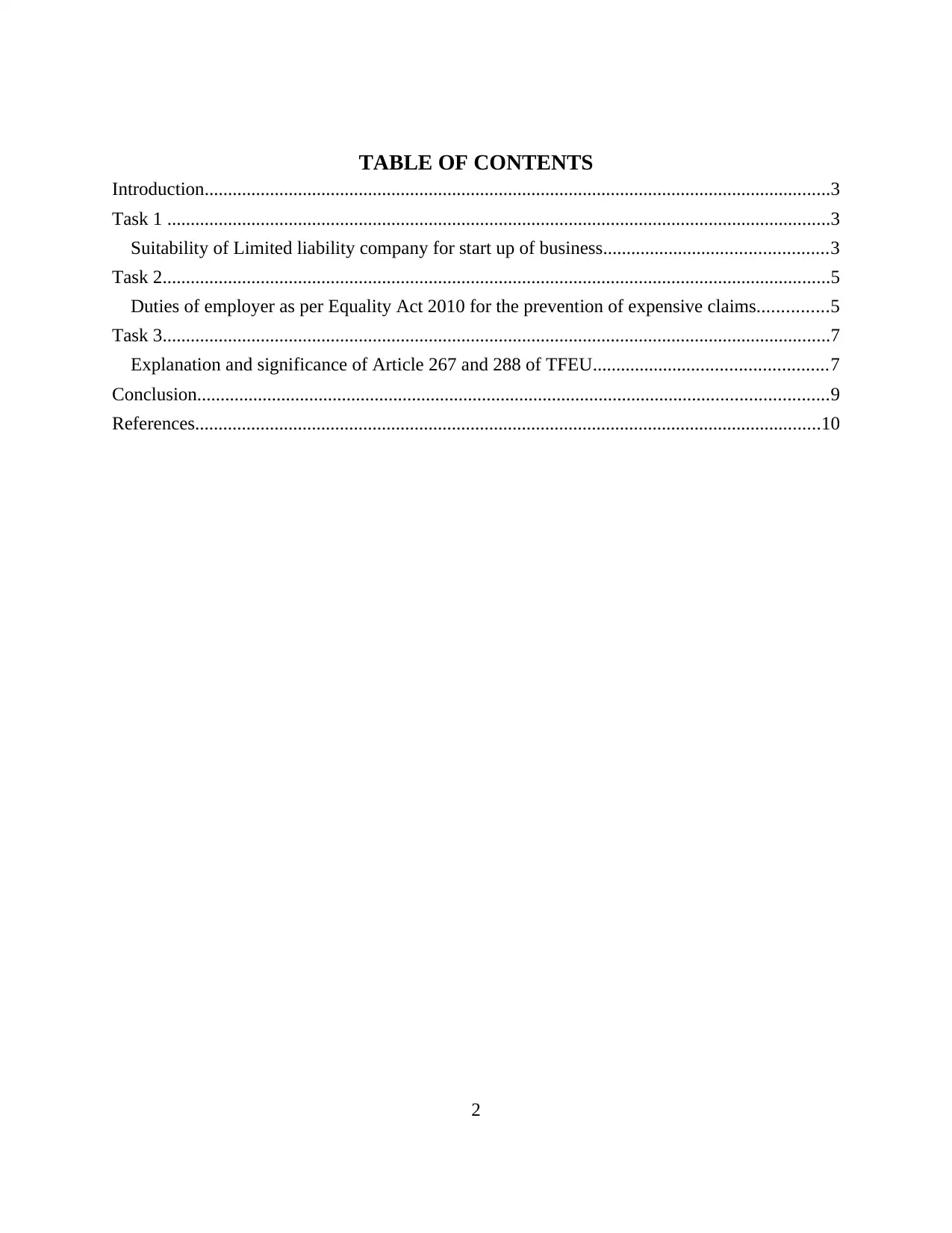
TABLE OF CONTENTS
Introduction......................................................................................................................................3
Task 1 ..............................................................................................................................................3
Suitability of Limited liability company for start up of business................................................3
Task 2...............................................................................................................................................5
Duties of employer as per Equality Act 2010 for the prevention of expensive claims...............5
Task 3...............................................................................................................................................7
Explanation and significance of Article 267 and 288 of TFEU..................................................7
Conclusion.......................................................................................................................................9
References......................................................................................................................................10
2
Introduction......................................................................................................................................3
Task 1 ..............................................................................................................................................3
Suitability of Limited liability company for start up of business................................................3
Task 2...............................................................................................................................................5
Duties of employer as per Equality Act 2010 for the prevention of expensive claims...............5
Task 3...............................................................................................................................................7
Explanation and significance of Article 267 and 288 of TFEU..................................................7
Conclusion.......................................................................................................................................9
References......................................................................................................................................10
2
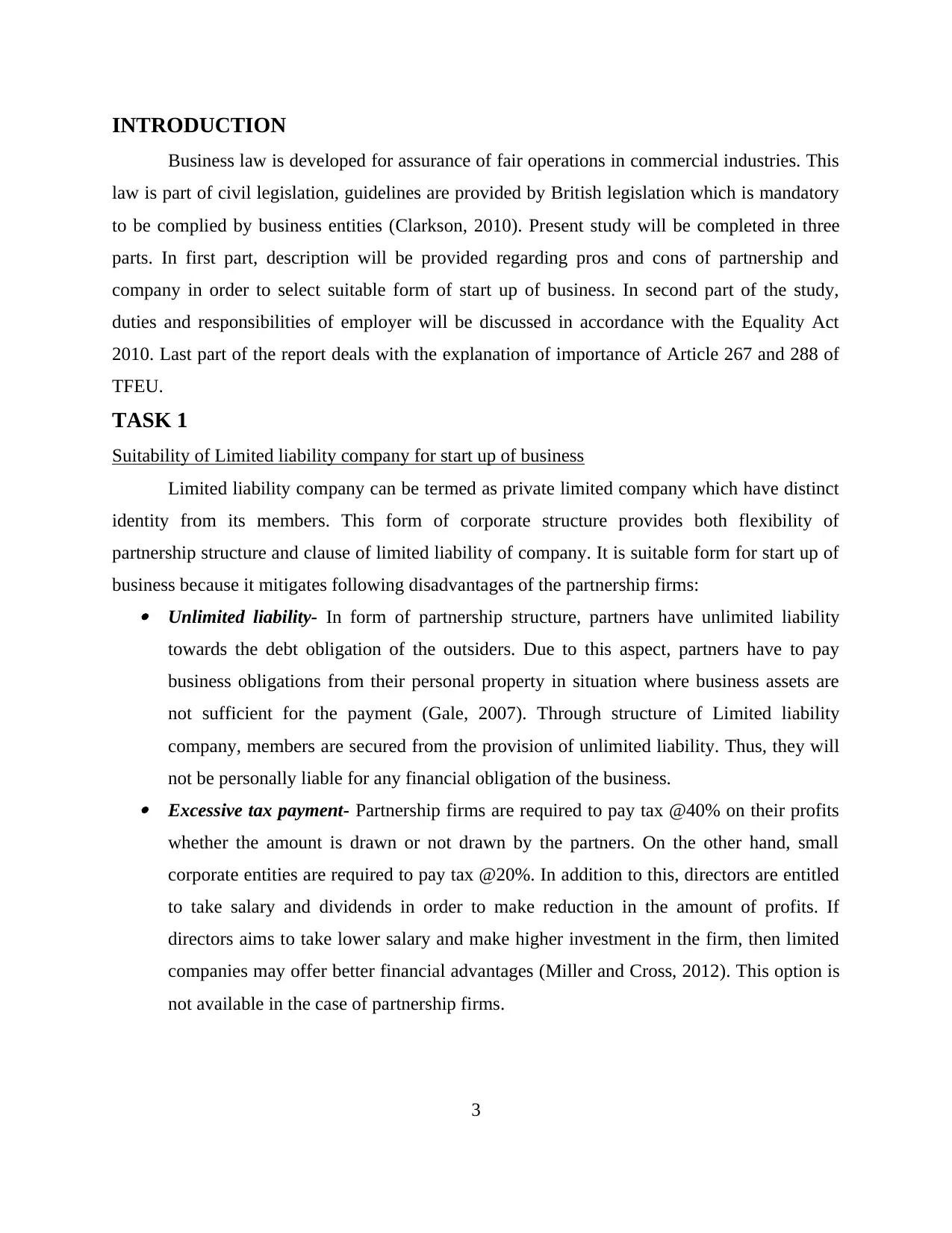
INTRODUCTION
Business law is developed for assurance of fair operations in commercial industries. This
law is part of civil legislation, guidelines are provided by British legislation which is mandatory
to be complied by business entities (Clarkson, 2010). Present study will be completed in three
parts. In first part, description will be provided regarding pros and cons of partnership and
company in order to select suitable form of start up of business. In second part of the study,
duties and responsibilities of employer will be discussed in accordance with the Equality Act
2010. Last part of the report deals with the explanation of importance of Article 267 and 288 of
TFEU.
TASK 1
Suitability of Limited liability company for start up of business
Limited liability company can be termed as private limited company which have distinct
identity from its members. This form of corporate structure provides both flexibility of
partnership structure and clause of limited liability of company. It is suitable form for start up of
business because it mitigates following disadvantages of the partnership firms: Unlimited liability- In form of partnership structure, partners have unlimited liability
towards the debt obligation of the outsiders. Due to this aspect, partners have to pay
business obligations from their personal property in situation where business assets are
not sufficient for the payment (Gale, 2007). Through structure of Limited liability
company, members are secured from the provision of unlimited liability. Thus, they will
not be personally liable for any financial obligation of the business. Excessive tax payment- Partnership firms are required to pay tax @40% on their profits
whether the amount is drawn or not drawn by the partners. On the other hand, small
corporate entities are required to pay tax @20%. In addition to this, directors are entitled
to take salary and dividends in order to make reduction in the amount of profits. If
directors aims to take lower salary and make higher investment in the firm, then limited
companies may offer better financial advantages (Miller and Cross, 2012). This option is
not available in the case of partnership firms.
3
Business law is developed for assurance of fair operations in commercial industries. This
law is part of civil legislation, guidelines are provided by British legislation which is mandatory
to be complied by business entities (Clarkson, 2010). Present study will be completed in three
parts. In first part, description will be provided regarding pros and cons of partnership and
company in order to select suitable form of start up of business. In second part of the study,
duties and responsibilities of employer will be discussed in accordance with the Equality Act
2010. Last part of the report deals with the explanation of importance of Article 267 and 288 of
TFEU.
TASK 1
Suitability of Limited liability company for start up of business
Limited liability company can be termed as private limited company which have distinct
identity from its members. This form of corporate structure provides both flexibility of
partnership structure and clause of limited liability of company. It is suitable form for start up of
business because it mitigates following disadvantages of the partnership firms: Unlimited liability- In form of partnership structure, partners have unlimited liability
towards the debt obligation of the outsiders. Due to this aspect, partners have to pay
business obligations from their personal property in situation where business assets are
not sufficient for the payment (Gale, 2007). Through structure of Limited liability
company, members are secured from the provision of unlimited liability. Thus, they will
not be personally liable for any financial obligation of the business. Excessive tax payment- Partnership firms are required to pay tax @40% on their profits
whether the amount is drawn or not drawn by the partners. On the other hand, small
corporate entities are required to pay tax @20%. In addition to this, directors are entitled
to take salary and dividends in order to make reduction in the amount of profits. If
directors aims to take lower salary and make higher investment in the firm, then limited
companies may offer better financial advantages (Miller and Cross, 2012). This option is
not available in the case of partnership firms.
3
⊘ This is a preview!⊘
Do you want full access?
Subscribe today to unlock all pages.

Trusted by 1+ million students worldwide
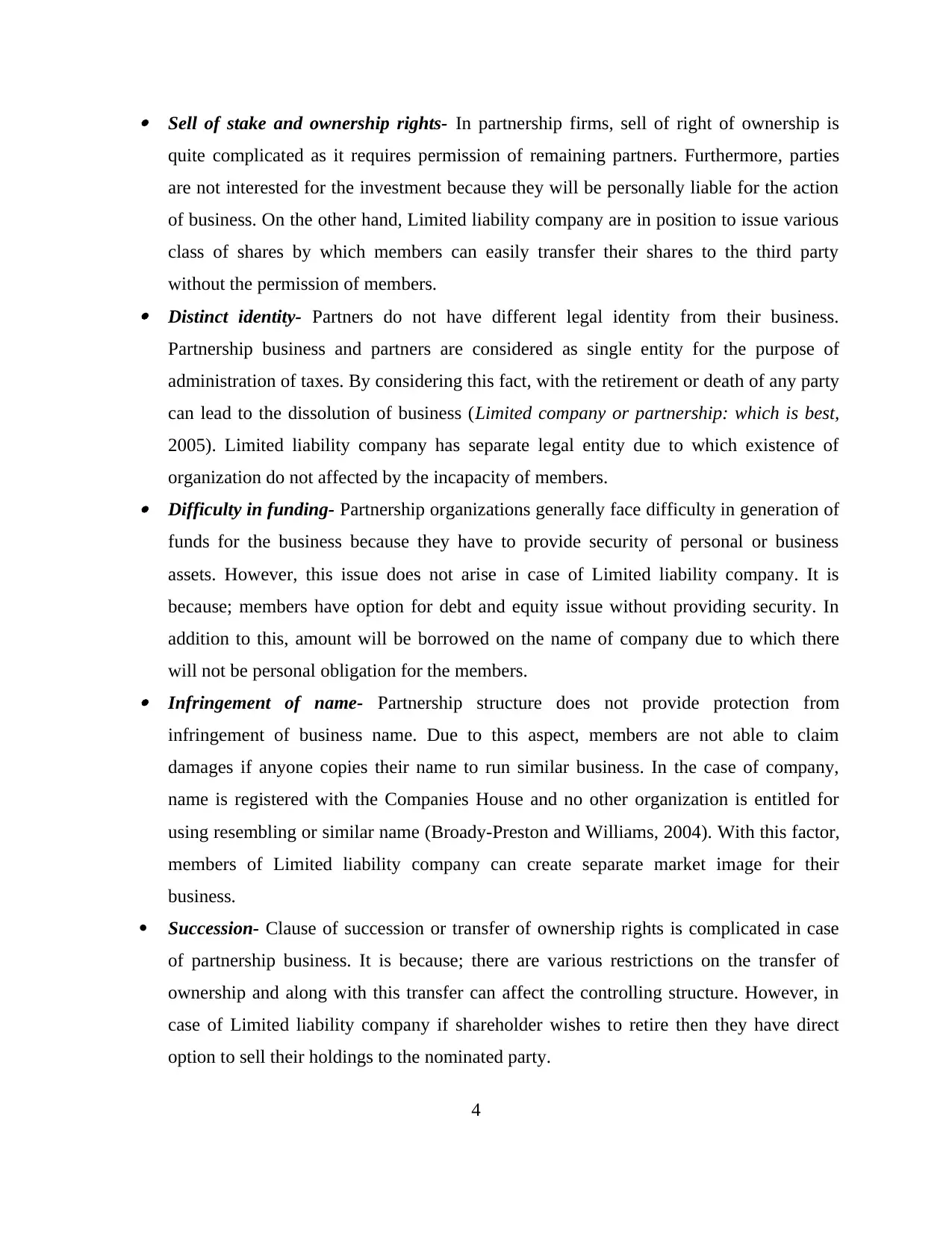
Sell of stake and ownership rights- In partnership firms, sell of right of ownership is
quite complicated as it requires permission of remaining partners. Furthermore, parties
are not interested for the investment because they will be personally liable for the action
of business. On the other hand, Limited liability company are in position to issue various
class of shares by which members can easily transfer their shares to the third party
without the permission of members. Distinct identity- Partners do not have different legal identity from their business.
Partnership business and partners are considered as single entity for the purpose of
administration of taxes. By considering this fact, with the retirement or death of any party
can lead to the dissolution of business (Limited company or partnership: which is best,
2005). Limited liability company has separate legal entity due to which existence of
organization do not affected by the incapacity of members. Difficulty in funding- Partnership organizations generally face difficulty in generation of
funds for the business because they have to provide security of personal or business
assets. However, this issue does not arise in case of Limited liability company. It is
because; members have option for debt and equity issue without providing security. In
addition to this, amount will be borrowed on the name of company due to which there
will not be personal obligation for the members. Infringement of name- Partnership structure does not provide protection from
infringement of business name. Due to this aspect, members are not able to claim
damages if anyone copies their name to run similar business. In the case of company,
name is registered with the Companies House and no other organization is entitled for
using resembling or similar name (Broady-Preston and Williams, 2004). With this factor,
members of Limited liability company can create separate market image for their
business.
Succession- Clause of succession or transfer of ownership rights is complicated in case
of partnership business. It is because; there are various restrictions on the transfer of
ownership and along with this transfer can affect the controlling structure. However, in
case of Limited liability company if shareholder wishes to retire then they have direct
option to sell their holdings to the nominated party.
4
quite complicated as it requires permission of remaining partners. Furthermore, parties
are not interested for the investment because they will be personally liable for the action
of business. On the other hand, Limited liability company are in position to issue various
class of shares by which members can easily transfer their shares to the third party
without the permission of members. Distinct identity- Partners do not have different legal identity from their business.
Partnership business and partners are considered as single entity for the purpose of
administration of taxes. By considering this fact, with the retirement or death of any party
can lead to the dissolution of business (Limited company or partnership: which is best,
2005). Limited liability company has separate legal entity due to which existence of
organization do not affected by the incapacity of members. Difficulty in funding- Partnership organizations generally face difficulty in generation of
funds for the business because they have to provide security of personal or business
assets. However, this issue does not arise in case of Limited liability company. It is
because; members have option for debt and equity issue without providing security. In
addition to this, amount will be borrowed on the name of company due to which there
will not be personal obligation for the members. Infringement of name- Partnership structure does not provide protection from
infringement of business name. Due to this aspect, members are not able to claim
damages if anyone copies their name to run similar business. In the case of company,
name is registered with the Companies House and no other organization is entitled for
using resembling or similar name (Broady-Preston and Williams, 2004). With this factor,
members of Limited liability company can create separate market image for their
business.
Succession- Clause of succession or transfer of ownership rights is complicated in case
of partnership business. It is because; there are various restrictions on the transfer of
ownership and along with this transfer can affect the controlling structure. However, in
case of Limited liability company if shareholder wishes to retire then they have direct
option to sell their holdings to the nominated party.
4
Paraphrase This Document
Need a fresh take? Get an instant paraphrase of this document with our AI Paraphraser
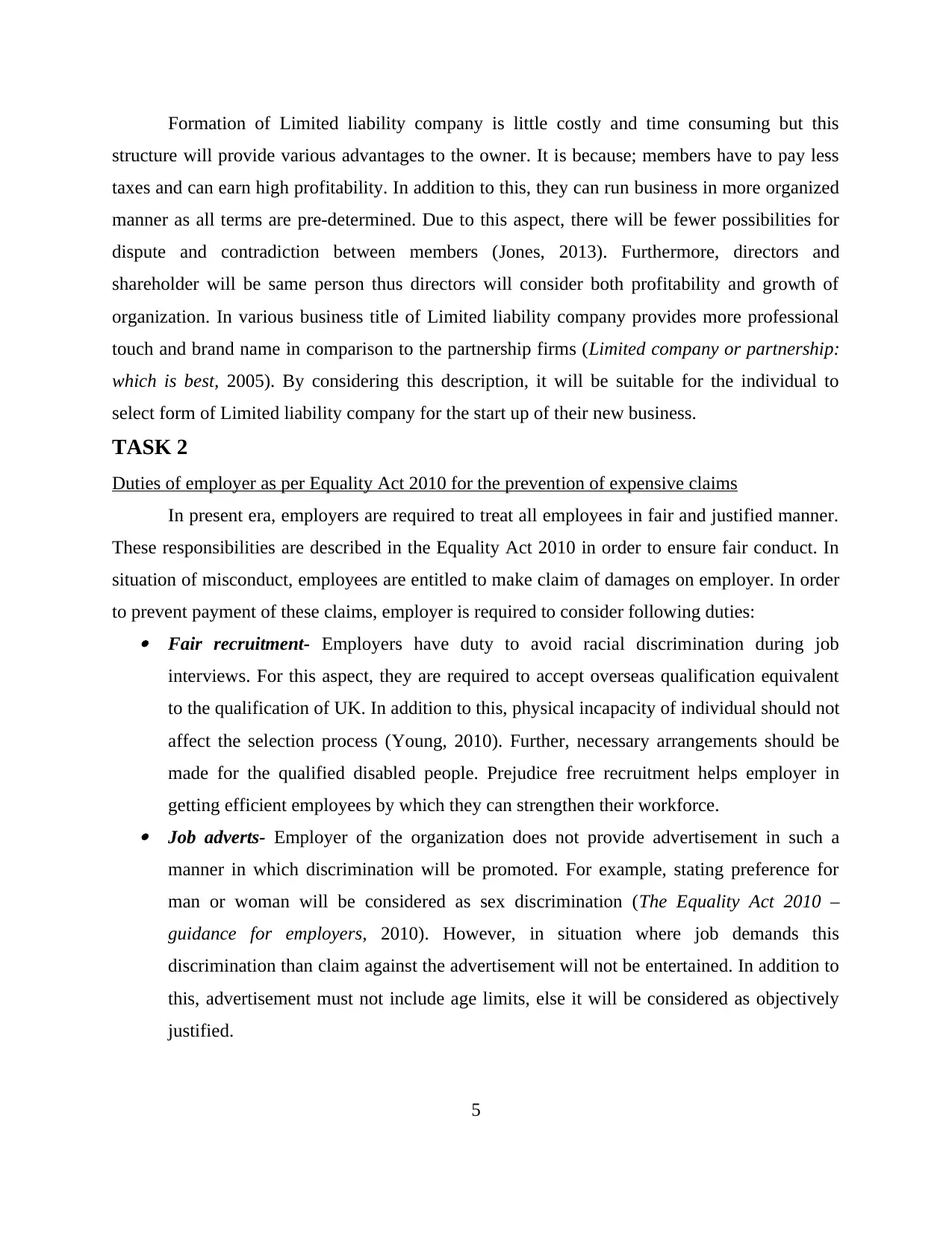
Formation of Limited liability company is little costly and time consuming but this
structure will provide various advantages to the owner. It is because; members have to pay less
taxes and can earn high profitability. In addition to this, they can run business in more organized
manner as all terms are pre-determined. Due to this aspect, there will be fewer possibilities for
dispute and contradiction between members (Jones, 2013). Furthermore, directors and
shareholder will be same person thus directors will consider both profitability and growth of
organization. In various business title of Limited liability company provides more professional
touch and brand name in comparison to the partnership firms (Limited company or partnership:
which is best, 2005). By considering this description, it will be suitable for the individual to
select form of Limited liability company for the start up of their new business.
TASK 2
Duties of employer as per Equality Act 2010 for the prevention of expensive claims
In present era, employers are required to treat all employees in fair and justified manner.
These responsibilities are described in the Equality Act 2010 in order to ensure fair conduct. In
situation of misconduct, employees are entitled to make claim of damages on employer. In order
to prevent payment of these claims, employer is required to consider following duties: Fair recruitment- Employers have duty to avoid racial discrimination during job
interviews. For this aspect, they are required to accept overseas qualification equivalent
to the qualification of UK. In addition to this, physical incapacity of individual should not
affect the selection process (Young, 2010). Further, necessary arrangements should be
made for the qualified disabled people. Prejudice free recruitment helps employer in
getting efficient employees by which they can strengthen their workforce. Job adverts- Employer of the organization does not provide advertisement in such a
manner in which discrimination will be promoted. For example, stating preference for
man or woman will be considered as sex discrimination (The Equality Act 2010 –
guidance for employers, 2010). However, in situation where job demands this
discrimination than claim against the advertisement will not be entertained. In addition to
this, advertisement must not include age limits, else it will be considered as objectively
justified.
5
structure will provide various advantages to the owner. It is because; members have to pay less
taxes and can earn high profitability. In addition to this, they can run business in more organized
manner as all terms are pre-determined. Due to this aspect, there will be fewer possibilities for
dispute and contradiction between members (Jones, 2013). Furthermore, directors and
shareholder will be same person thus directors will consider both profitability and growth of
organization. In various business title of Limited liability company provides more professional
touch and brand name in comparison to the partnership firms (Limited company or partnership:
which is best, 2005). By considering this description, it will be suitable for the individual to
select form of Limited liability company for the start up of their new business.
TASK 2
Duties of employer as per Equality Act 2010 for the prevention of expensive claims
In present era, employers are required to treat all employees in fair and justified manner.
These responsibilities are described in the Equality Act 2010 in order to ensure fair conduct. In
situation of misconduct, employees are entitled to make claim of damages on employer. In order
to prevent payment of these claims, employer is required to consider following duties: Fair recruitment- Employers have duty to avoid racial discrimination during job
interviews. For this aspect, they are required to accept overseas qualification equivalent
to the qualification of UK. In addition to this, physical incapacity of individual should not
affect the selection process (Young, 2010). Further, necessary arrangements should be
made for the qualified disabled people. Prejudice free recruitment helps employer in
getting efficient employees by which they can strengthen their workforce. Job adverts- Employer of the organization does not provide advertisement in such a
manner in which discrimination will be promoted. For example, stating preference for
man or woman will be considered as sex discrimination (The Equality Act 2010 –
guidance for employers, 2010). However, in situation where job demands this
discrimination than claim against the advertisement will not be entertained. In addition to
this, advertisement must not include age limits, else it will be considered as objectively
justified.
5
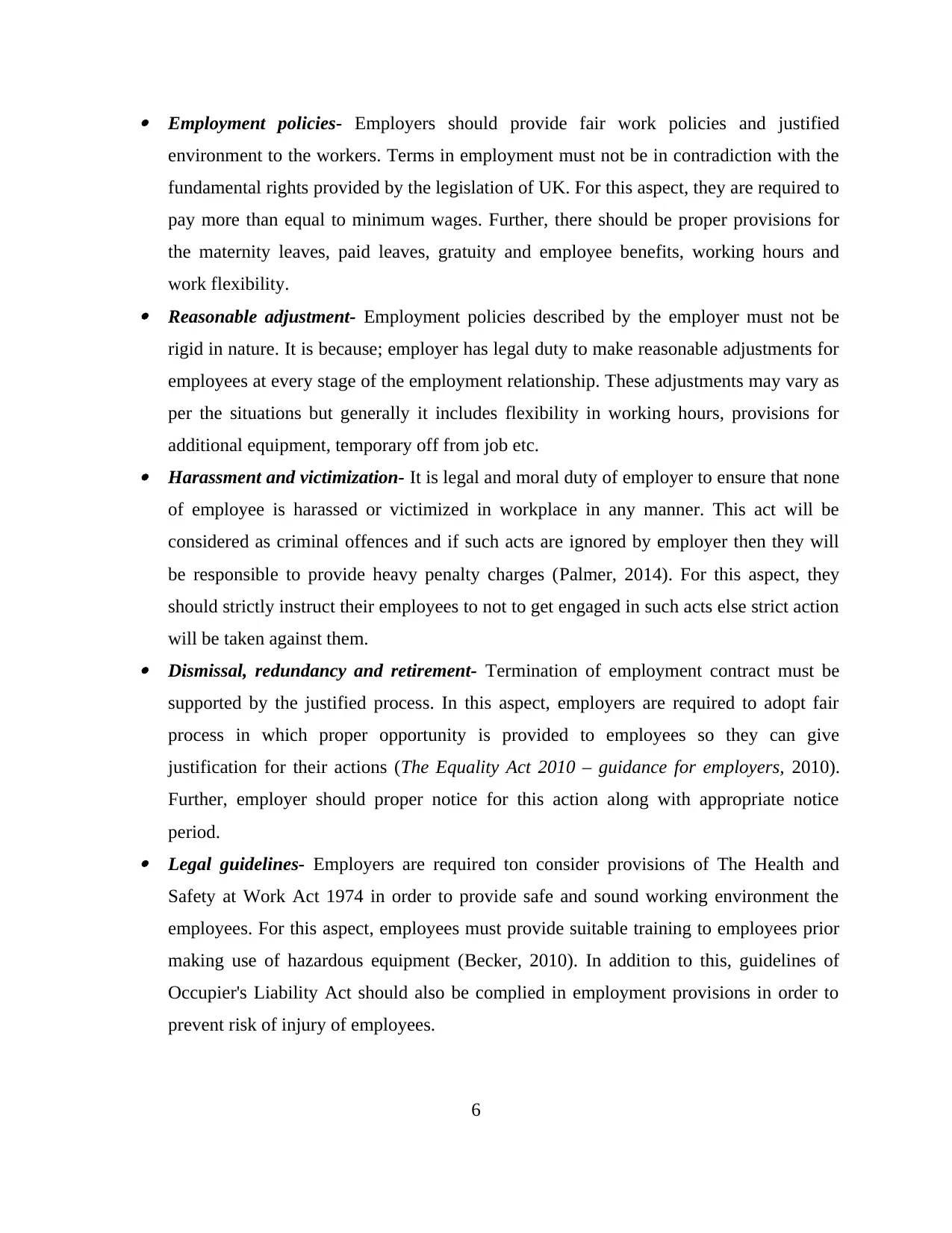
Employment policies- Employers should provide fair work policies and justified
environment to the workers. Terms in employment must not be in contradiction with the
fundamental rights provided by the legislation of UK. For this aspect, they are required to
pay more than equal to minimum wages. Further, there should be proper provisions for
the maternity leaves, paid leaves, gratuity and employee benefits, working hours and
work flexibility. Reasonable adjustment- Employment policies described by the employer must not be
rigid in nature. It is because; employer has legal duty to make reasonable adjustments for
employees at every stage of the employment relationship. These adjustments may vary as
per the situations but generally it includes flexibility in working hours, provisions for
additional equipment, temporary off from job etc. Harassment and victimization- It is legal and moral duty of employer to ensure that none
of employee is harassed or victimized in workplace in any manner. This act will be
considered as criminal offences and if such acts are ignored by employer then they will
be responsible to provide heavy penalty charges (Palmer, 2014). For this aspect, they
should strictly instruct their employees to not to get engaged in such acts else strict action
will be taken against them. Dismissal, redundancy and retirement- Termination of employment contract must be
supported by the justified process. In this aspect, employers are required to adopt fair
process in which proper opportunity is provided to employees so they can give
justification for their actions (The Equality Act 2010 – guidance for employers, 2010).
Further, employer should proper notice for this action along with appropriate notice
period. Legal guidelines- Employers are required ton consider provisions of The Health and
Safety at Work Act 1974 in order to provide safe and sound working environment the
employees. For this aspect, employees must provide suitable training to employees prior
making use of hazardous equipment (Becker, 2010). In addition to this, guidelines of
Occupier's Liability Act should also be complied in employment provisions in order to
prevent risk of injury of employees.
6
environment to the workers. Terms in employment must not be in contradiction with the
fundamental rights provided by the legislation of UK. For this aspect, they are required to
pay more than equal to minimum wages. Further, there should be proper provisions for
the maternity leaves, paid leaves, gratuity and employee benefits, working hours and
work flexibility. Reasonable adjustment- Employment policies described by the employer must not be
rigid in nature. It is because; employer has legal duty to make reasonable adjustments for
employees at every stage of the employment relationship. These adjustments may vary as
per the situations but generally it includes flexibility in working hours, provisions for
additional equipment, temporary off from job etc. Harassment and victimization- It is legal and moral duty of employer to ensure that none
of employee is harassed or victimized in workplace in any manner. This act will be
considered as criminal offences and if such acts are ignored by employer then they will
be responsible to provide heavy penalty charges (Palmer, 2014). For this aspect, they
should strictly instruct their employees to not to get engaged in such acts else strict action
will be taken against them. Dismissal, redundancy and retirement- Termination of employment contract must be
supported by the justified process. In this aspect, employers are required to adopt fair
process in which proper opportunity is provided to employees so they can give
justification for their actions (The Equality Act 2010 – guidance for employers, 2010).
Further, employer should proper notice for this action along with appropriate notice
period. Legal guidelines- Employers are required ton consider provisions of The Health and
Safety at Work Act 1974 in order to provide safe and sound working environment the
employees. For this aspect, employees must provide suitable training to employees prior
making use of hazardous equipment (Becker, 2010). In addition to this, guidelines of
Occupier's Liability Act should also be complied in employment provisions in order to
prevent risk of injury of employees.
6
⊘ This is a preview!⊘
Do you want full access?
Subscribe today to unlock all pages.

Trusted by 1+ million students worldwide
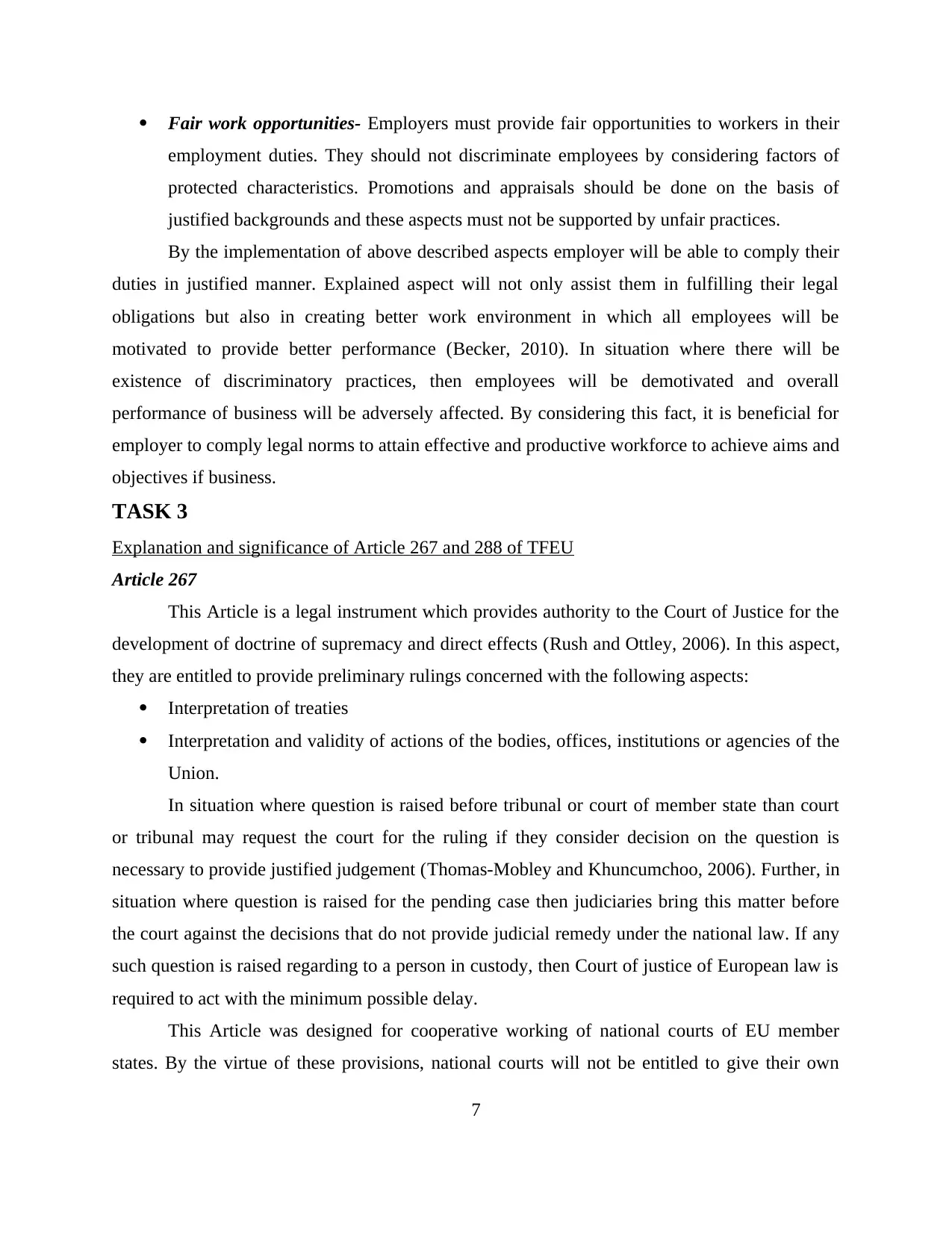
Fair work opportunities- Employers must provide fair opportunities to workers in their
employment duties. They should not discriminate employees by considering factors of
protected characteristics. Promotions and appraisals should be done on the basis of
justified backgrounds and these aspects must not be supported by unfair practices.
By the implementation of above described aspects employer will be able to comply their
duties in justified manner. Explained aspect will not only assist them in fulfilling their legal
obligations but also in creating better work environment in which all employees will be
motivated to provide better performance (Becker, 2010). In situation where there will be
existence of discriminatory practices, then employees will be demotivated and overall
performance of business will be adversely affected. By considering this fact, it is beneficial for
employer to comply legal norms to attain effective and productive workforce to achieve aims and
objectives if business.
TASK 3
Explanation and significance of Article 267 and 288 of TFEU
Article 267
This Article is a legal instrument which provides authority to the Court of Justice for the
development of doctrine of supremacy and direct effects (Rush and Ottley, 2006). In this aspect,
they are entitled to provide preliminary rulings concerned with the following aspects:
Interpretation of treaties
Interpretation and validity of actions of the bodies, offices, institutions or agencies of the
Union.
In situation where question is raised before tribunal or court of member state than court
or tribunal may request the court for the ruling if they consider decision on the question is
necessary to provide justified judgement (Thomas-Mobley and Khuncumchoo, 2006). Further, in
situation where question is raised for the pending case then judiciaries bring this matter before
the court against the decisions that do not provide judicial remedy under the national law. If any
such question is raised regarding to a person in custody, then Court of justice of European law is
required to act with the minimum possible delay.
This Article was designed for cooperative working of national courts of EU member
states. By the virtue of these provisions, national courts will not be entitled to give their own
7
employment duties. They should not discriminate employees by considering factors of
protected characteristics. Promotions and appraisals should be done on the basis of
justified backgrounds and these aspects must not be supported by unfair practices.
By the implementation of above described aspects employer will be able to comply their
duties in justified manner. Explained aspect will not only assist them in fulfilling their legal
obligations but also in creating better work environment in which all employees will be
motivated to provide better performance (Becker, 2010). In situation where there will be
existence of discriminatory practices, then employees will be demotivated and overall
performance of business will be adversely affected. By considering this fact, it is beneficial for
employer to comply legal norms to attain effective and productive workforce to achieve aims and
objectives if business.
TASK 3
Explanation and significance of Article 267 and 288 of TFEU
Article 267
This Article is a legal instrument which provides authority to the Court of Justice for the
development of doctrine of supremacy and direct effects (Rush and Ottley, 2006). In this aspect,
they are entitled to provide preliminary rulings concerned with the following aspects:
Interpretation of treaties
Interpretation and validity of actions of the bodies, offices, institutions or agencies of the
Union.
In situation where question is raised before tribunal or court of member state than court
or tribunal may request the court for the ruling if they consider decision on the question is
necessary to provide justified judgement (Thomas-Mobley and Khuncumchoo, 2006). Further, in
situation where question is raised for the pending case then judiciaries bring this matter before
the court against the decisions that do not provide judicial remedy under the national law. If any
such question is raised regarding to a person in custody, then Court of justice of European law is
required to act with the minimum possible delay.
This Article was designed for cooperative working of national courts of EU member
states. By the virtue of these provisions, national courts will not be entitled to give their own
7
Paraphrase This Document
Need a fresh take? Get an instant paraphrase of this document with our AI Paraphraser
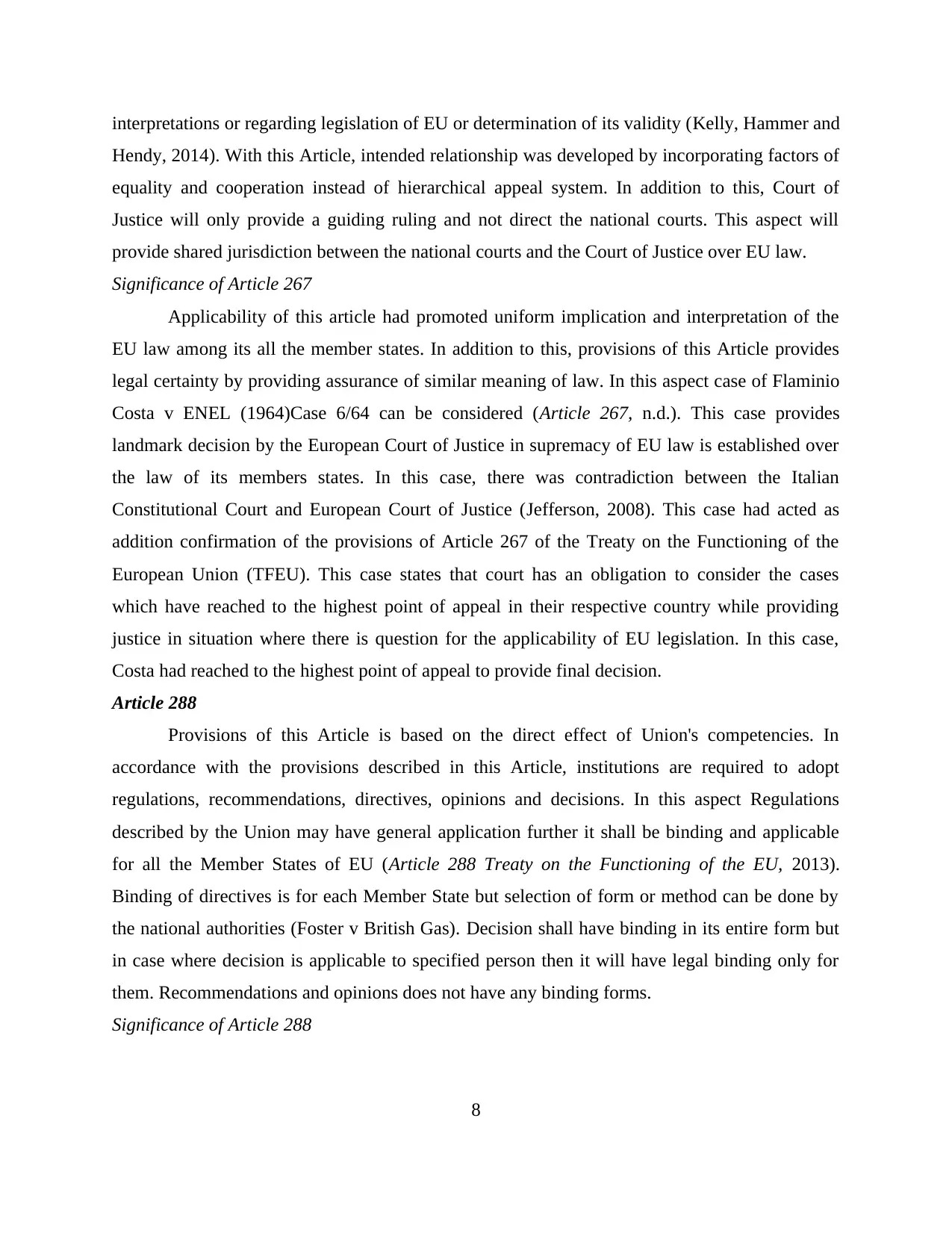
interpretations or regarding legislation of EU or determination of its validity (Kelly, Hammer and
Hendy, 2014). With this Article, intended relationship was developed by incorporating factors of
equality and cooperation instead of hierarchical appeal system. In addition to this, Court of
Justice will only provide a guiding ruling and not direct the national courts. This aspect will
provide shared jurisdiction between the national courts and the Court of Justice over EU law.
Significance of Article 267
Applicability of this article had promoted uniform implication and interpretation of the
EU law among its all the member states. In addition to this, provisions of this Article provides
legal certainty by providing assurance of similar meaning of law. In this aspect case of Flaminio
Costa v ENEL (1964)Case 6/64 can be considered (Article 267, n.d.). This case provides
landmark decision by the European Court of Justice in supremacy of EU law is established over
the law of its members states. In this case, there was contradiction between the Italian
Constitutional Court and European Court of Justice (Jefferson, 2008). This case had acted as
addition confirmation of the provisions of Article 267 of the Treaty on the Functioning of the
European Union (TFEU). This case states that court has an obligation to consider the cases
which have reached to the highest point of appeal in their respective country while providing
justice in situation where there is question for the applicability of EU legislation. In this case,
Costa had reached to the highest point of appeal to provide final decision.
Article 288
Provisions of this Article is based on the direct effect of Union's competencies. In
accordance with the provisions described in this Article, institutions are required to adopt
regulations, recommendations, directives, opinions and decisions. In this aspect Regulations
described by the Union may have general application further it shall be binding and applicable
for all the Member States of EU (Article 288 Treaty on the Functioning of the EU, 2013).
Binding of directives is for each Member State but selection of form or method can be done by
the national authorities (Foster v British Gas). Decision shall have binding in its entire form but
in case where decision is applicable to specified person then it will have legal binding only for
them. Recommendations and opinions does not have any binding forms.
Significance of Article 288
8
Hendy, 2014). With this Article, intended relationship was developed by incorporating factors of
equality and cooperation instead of hierarchical appeal system. In addition to this, Court of
Justice will only provide a guiding ruling and not direct the national courts. This aspect will
provide shared jurisdiction between the national courts and the Court of Justice over EU law.
Significance of Article 267
Applicability of this article had promoted uniform implication and interpretation of the
EU law among its all the member states. In addition to this, provisions of this Article provides
legal certainty by providing assurance of similar meaning of law. In this aspect case of Flaminio
Costa v ENEL (1964)Case 6/64 can be considered (Article 267, n.d.). This case provides
landmark decision by the European Court of Justice in supremacy of EU law is established over
the law of its members states. In this case, there was contradiction between the Italian
Constitutional Court and European Court of Justice (Jefferson, 2008). This case had acted as
addition confirmation of the provisions of Article 267 of the Treaty on the Functioning of the
European Union (TFEU). This case states that court has an obligation to consider the cases
which have reached to the highest point of appeal in their respective country while providing
justice in situation where there is question for the applicability of EU legislation. In this case,
Costa had reached to the highest point of appeal to provide final decision.
Article 288
Provisions of this Article is based on the direct effect of Union's competencies. In
accordance with the provisions described in this Article, institutions are required to adopt
regulations, recommendations, directives, opinions and decisions. In this aspect Regulations
described by the Union may have general application further it shall be binding and applicable
for all the Member States of EU (Article 288 Treaty on the Functioning of the EU, 2013).
Binding of directives is for each Member State but selection of form or method can be done by
the national authorities (Foster v British Gas). Decision shall have binding in its entire form but
in case where decision is applicable to specified person then it will have legal binding only for
them. Recommendations and opinions does not have any binding forms.
Significance of Article 288
8
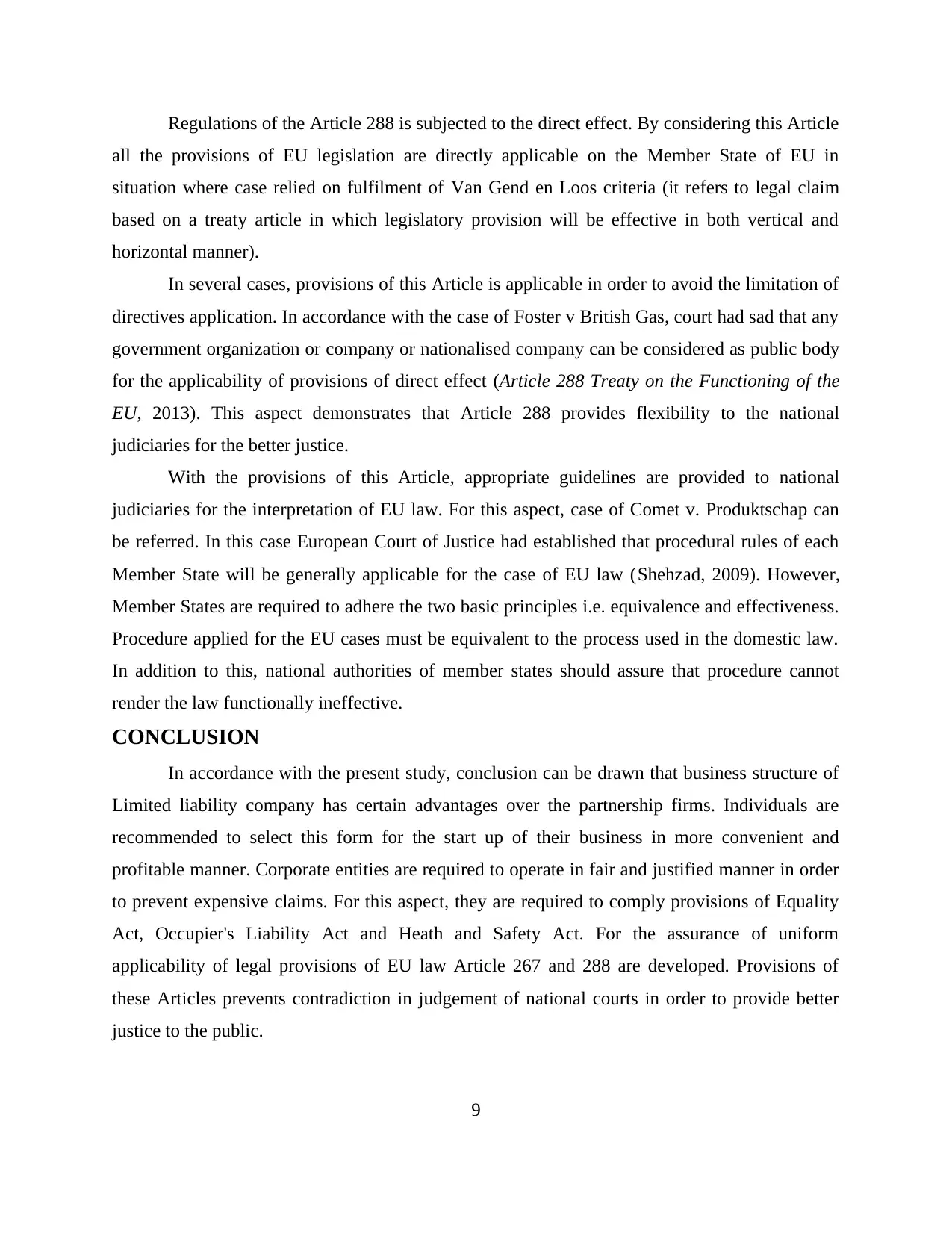
Regulations of the Article 288 is subjected to the direct effect. By considering this Article
all the provisions of EU legislation are directly applicable on the Member State of EU in
situation where case relied on fulfilment of Van Gend en Loos criteria (it refers to legal claim
based on a treaty article in which legislatory provision will be effective in both vertical and
horizontal manner).
In several cases, provisions of this Article is applicable in order to avoid the limitation of
directives application. In accordance with the case of Foster v British Gas, court had sad that any
government organization or company or nationalised company can be considered as public body
for the applicability of provisions of direct effect (Article 288 Treaty on the Functioning of the
EU, 2013). This aspect demonstrates that Article 288 provides flexibility to the national
judiciaries for the better justice.
With the provisions of this Article, appropriate guidelines are provided to national
judiciaries for the interpretation of EU law. For this aspect, case of Comet v. Produktschap can
be referred. In this case European Court of Justice had established that procedural rules of each
Member State will be generally applicable for the case of EU law (Shehzad, 2009). However,
Member States are required to adhere the two basic principles i.e. equivalence and effectiveness.
Procedure applied for the EU cases must be equivalent to the process used in the domestic law.
In addition to this, national authorities of member states should assure that procedure cannot
render the law functionally ineffective.
CONCLUSION
In accordance with the present study, conclusion can be drawn that business structure of
Limited liability company has certain advantages over the partnership firms. Individuals are
recommended to select this form for the start up of their business in more convenient and
profitable manner. Corporate entities are required to operate in fair and justified manner in order
to prevent expensive claims. For this aspect, they are required to comply provisions of Equality
Act, Occupier's Liability Act and Heath and Safety Act. For the assurance of uniform
applicability of legal provisions of EU law Article 267 and 288 are developed. Provisions of
these Articles prevents contradiction in judgement of national courts in order to provide better
justice to the public.
9
all the provisions of EU legislation are directly applicable on the Member State of EU in
situation where case relied on fulfilment of Van Gend en Loos criteria (it refers to legal claim
based on a treaty article in which legislatory provision will be effective in both vertical and
horizontal manner).
In several cases, provisions of this Article is applicable in order to avoid the limitation of
directives application. In accordance with the case of Foster v British Gas, court had sad that any
government organization or company or nationalised company can be considered as public body
for the applicability of provisions of direct effect (Article 288 Treaty on the Functioning of the
EU, 2013). This aspect demonstrates that Article 288 provides flexibility to the national
judiciaries for the better justice.
With the provisions of this Article, appropriate guidelines are provided to national
judiciaries for the interpretation of EU law. For this aspect, case of Comet v. Produktschap can
be referred. In this case European Court of Justice had established that procedural rules of each
Member State will be generally applicable for the case of EU law (Shehzad, 2009). However,
Member States are required to adhere the two basic principles i.e. equivalence and effectiveness.
Procedure applied for the EU cases must be equivalent to the process used in the domestic law.
In addition to this, national authorities of member states should assure that procedure cannot
render the law functionally ineffective.
CONCLUSION
In accordance with the present study, conclusion can be drawn that business structure of
Limited liability company has certain advantages over the partnership firms. Individuals are
recommended to select this form for the start up of their business in more convenient and
profitable manner. Corporate entities are required to operate in fair and justified manner in order
to prevent expensive claims. For this aspect, they are required to comply provisions of Equality
Act, Occupier's Liability Act and Heath and Safety Act. For the assurance of uniform
applicability of legal provisions of EU law Article 267 and 288 are developed. Provisions of
these Articles prevents contradiction in judgement of national courts in order to provide better
justice to the public.
9
⊘ This is a preview!⊘
Do you want full access?
Subscribe today to unlock all pages.

Trusted by 1+ million students worldwide
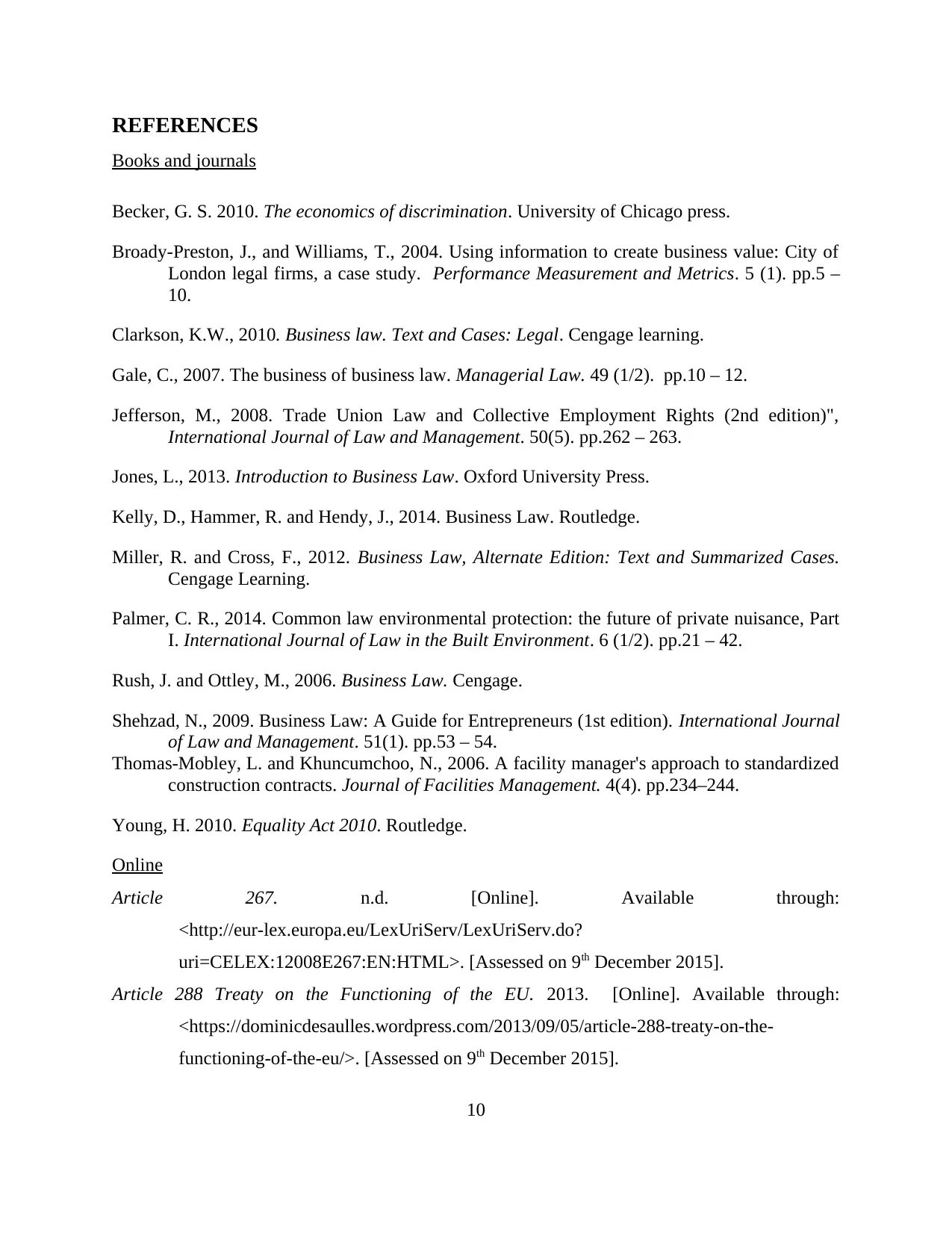
REFERENCES
Books and journals
Becker, G. S. 2010. The economics of discrimination. University of Chicago press.
Broady-Preston, J., and Williams, T., 2004. Using information to create business value: City of
London legal firms, a case study. Performance Measurement and Metrics. 5 (1). pp.5 –
10.
Clarkson, K.W., 2010. Business law. Text and Cases: Legal. Cengage learning.
Gale, C., 2007. The business of business law. Managerial Law. 49 (1/2). pp.10 – 12.
Jefferson, M., 2008. Trade Union Law and Collective Employment Rights (2nd edition)",
International Journal of Law and Management. 50(5). pp.262 – 263.
Jones, L., 2013. Introduction to Business Law. Oxford University Press.
Kelly, D., Hammer, R. and Hendy, J., 2014. Business Law. Routledge.
Miller, R. and Cross, F., 2012. Business Law, Alternate Edition: Text and Summarized Cases.
Cengage Learning.
Palmer, C. R., 2014. Common law environmental protection: the future of private nuisance, Part
I. International Journal of Law in the Built Environment. 6 (1/2). pp.21 – 42.
Rush, J. and Ottley, M., 2006. Business Law. Cengage.
Shehzad, N., 2009. Business Law: A Guide for Entrepreneurs (1st edition). International Journal
of Law and Management. 51(1). pp.53 – 54.
Thomas-Mobley, L. and Khuncumchoo, N., 2006. A facility manager's approach to standardized
construction contracts. Journal of Facilities Management. 4(4). pp.234–244.
Young, H. 2010. Equality Act 2010. Routledge.
Online
Article 267. n.d. [Online]. Available through:
<http://eur-lex.europa.eu/LexUriServ/LexUriServ.do?
uri=CELEX:12008E267:EN:HTML>. [Assessed on 9th December 2015].
Article 288 Treaty on the Functioning of the EU. 2013. [Online]. Available through:
<https://dominicdesaulles.wordpress.com/2013/09/05/article-288-treaty-on-the-
functioning-of-the-eu/>. [Assessed on 9th December 2015].
10
Books and journals
Becker, G. S. 2010. The economics of discrimination. University of Chicago press.
Broady-Preston, J., and Williams, T., 2004. Using information to create business value: City of
London legal firms, a case study. Performance Measurement and Metrics. 5 (1). pp.5 –
10.
Clarkson, K.W., 2010. Business law. Text and Cases: Legal. Cengage learning.
Gale, C., 2007. The business of business law. Managerial Law. 49 (1/2). pp.10 – 12.
Jefferson, M., 2008. Trade Union Law and Collective Employment Rights (2nd edition)",
International Journal of Law and Management. 50(5). pp.262 – 263.
Jones, L., 2013. Introduction to Business Law. Oxford University Press.
Kelly, D., Hammer, R. and Hendy, J., 2014. Business Law. Routledge.
Miller, R. and Cross, F., 2012. Business Law, Alternate Edition: Text and Summarized Cases.
Cengage Learning.
Palmer, C. R., 2014. Common law environmental protection: the future of private nuisance, Part
I. International Journal of Law in the Built Environment. 6 (1/2). pp.21 – 42.
Rush, J. and Ottley, M., 2006. Business Law. Cengage.
Shehzad, N., 2009. Business Law: A Guide for Entrepreneurs (1st edition). International Journal
of Law and Management. 51(1). pp.53 – 54.
Thomas-Mobley, L. and Khuncumchoo, N., 2006. A facility manager's approach to standardized
construction contracts. Journal of Facilities Management. 4(4). pp.234–244.
Young, H. 2010. Equality Act 2010. Routledge.
Online
Article 267. n.d. [Online]. Available through:
<http://eur-lex.europa.eu/LexUriServ/LexUriServ.do?
uri=CELEX:12008E267:EN:HTML>. [Assessed on 9th December 2015].
Article 288 Treaty on the Functioning of the EU. 2013. [Online]. Available through:
<https://dominicdesaulles.wordpress.com/2013/09/05/article-288-treaty-on-the-
functioning-of-the-eu/>. [Assessed on 9th December 2015].
10
Paraphrase This Document
Need a fresh take? Get an instant paraphrase of this document with our AI Paraphraser
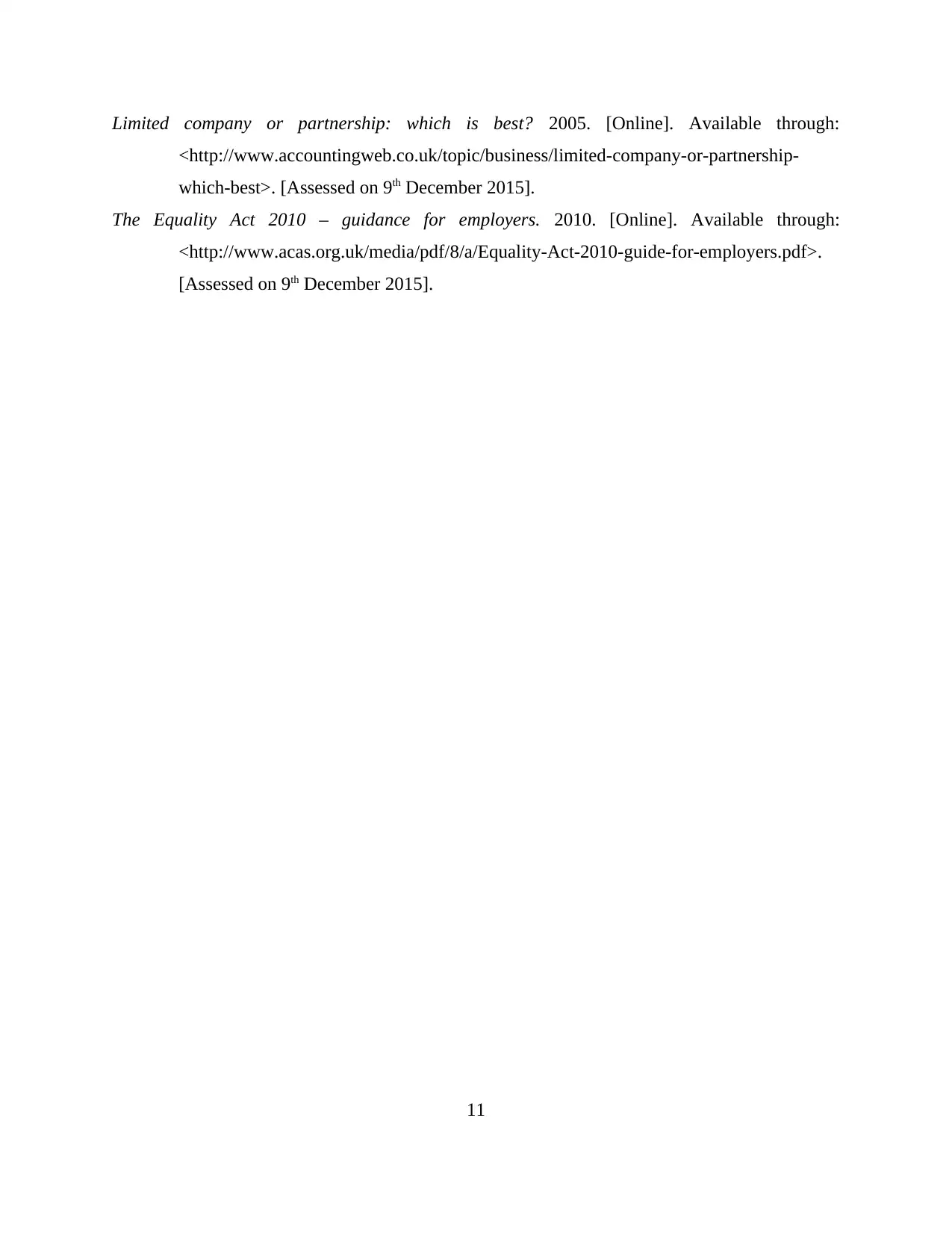
Limited company or partnership: which is best? 2005. [Online]. Available through:
<http://www.accountingweb.co.uk/topic/business/limited-company-or-partnership-
which-best>. [Assessed on 9th December 2015].
The Equality Act 2010 – guidance for employers. 2010. [Online]. Available through:
<http://www.acas.org.uk/media/pdf/8/a/Equality-Act-2010-guide-for-employers.pdf>.
[Assessed on 9th December 2015].
11
<http://www.accountingweb.co.uk/topic/business/limited-company-or-partnership-
which-best>. [Assessed on 9th December 2015].
The Equality Act 2010 – guidance for employers. 2010. [Online]. Available through:
<http://www.acas.org.uk/media/pdf/8/a/Equality-Act-2010-guide-for-employers.pdf>.
[Assessed on 9th December 2015].
11
1 out of 11
Related Documents
Your All-in-One AI-Powered Toolkit for Academic Success.
+13062052269
info@desklib.com
Available 24*7 on WhatsApp / Email
![[object Object]](/_next/static/media/star-bottom.7253800d.svg)
Unlock your academic potential
Copyright © 2020–2025 A2Z Services. All Rights Reserved. Developed and managed by ZUCOL.





